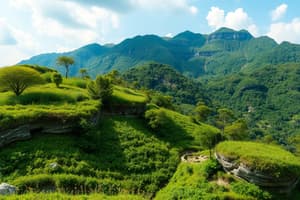Podcast
Questions and Answers
What is the basic functional unit of nature according to the Seven Environmental Principles?
What is the basic functional unit of nature according to the Seven Environmental Principles?
Which of the following components are included in ecosystems?
Which of the following components are included in ecosystems?
What primarily distinguishes protected areas in the Philippine ecosystem?
What primarily distinguishes protected areas in the Philippine ecosystem?
Which of the following is NOT a characteristic of freshwater and wetlands ecosystems?
Which of the following is NOT a characteristic of freshwater and wetlands ecosystems?
Signup and view all the answers
What type of ecosystem includes communities of trees, shrubs, and animals as primary indicators?
What type of ecosystem includes communities of trees, shrubs, and animals as primary indicators?
Signup and view all the answers
Which ecosystem is located in areas considered unsuitable for wet rice cultivation without certain modifications?
Which ecosystem is located in areas considered unsuitable for wet rice cultivation without certain modifications?
Signup and view all the answers
Which of these statements about coastal and marine ecosystems is true?
Which of these statements about coastal and marine ecosystems is true?
Signup and view all the answers
What principle states that everything is connected to everything else in an ecosystem?
What principle states that everything is connected to everything else in an ecosystem?
Signup and view all the answers
What does biological diversity encompass?
What does biological diversity encompass?
Signup and view all the answers
Which aspect of biodiversity deals with variations within a species?
Which aspect of biodiversity deals with variations within a species?
Signup and view all the answers
Which principle states that 'everything must go somewhere'?
Which principle states that 'everything must go somewhere'?
Signup and view all the answers
What does sustainable development aim to achieve?
What does sustainable development aim to achieve?
Signup and view all the answers
Which of the following is a characteristic feature of non-renewable resources?
Which of the following is a characteristic feature of non-renewable resources?
Signup and view all the answers
What is an example of ex-situ conservation?
What is an example of ex-situ conservation?
Signup and view all the answers
Why is community involvement important in natural resource management?
Why is community involvement important in natural resource management?
Signup and view all the answers
What is a goal of integrated coastal resource management?
What is a goal of integrated coastal resource management?
Signup and view all the answers
What principle emphasizes the interconnectedness of ecosystems?
What principle emphasizes the interconnectedness of ecosystems?
Signup and view all the answers
Which of the following represents a linear change in nature?
Which of the following represents a linear change in nature?
Signup and view all the answers
According to the principles, what must happen to ensure a sustained yield of natural resources?
According to the principles, what must happen to ensure a sustained yield of natural resources?
Signup and view all the answers
What type of change is represented by the random eruption of Mt. Pinatubo?
What type of change is represented by the random eruption of Mt. Pinatubo?
Signup and view all the answers
Which of the following actions could contribute to habitat destruction?
Which of the following actions could contribute to habitat destruction?
Signup and view all the answers
Which principle suggests that biodiversity contributes to the importance of all forms of life?
Which principle suggests that biodiversity contributes to the importance of all forms of life?
Signup and view all the answers
What aspect does the principle 'Nature is Beautiful and We are Stewards of God’s Creation' emphasize?
What aspect does the principle 'Nature is Beautiful and We are Stewards of God’s Creation' emphasize?
Signup and view all the answers
Which of the following is NOT a form of disruption mentioned?
Which of the following is NOT a form of disruption mentioned?
Signup and view all the answers
Study Notes
Environment
- The environment is a complex system composed of living (plants, animals) and non-living entities (air, water, land, energy).
- The environment includes socio-economic components like people, communities, institutions, and values.
The Seven Environmental Principles by Barry Commoner
-
Everything is connected to everything else: Ecosystems are fundamental units of nature, representing the intricate interactions between living (community) and non-living components of the environment.
-
All forms of life are important: This principle underscores the need for biodiversity, recognizing that each organism plays a crucial role (niche) within an ecosystem.
-
Everything must go somewhere: This principle highlights the importance of waste management and environmental management systems, as there is no such thing as "away" when it comes to waste.
-
Ours is a finite earth: Emphasizes the need for conservation and sustainable development. The text describes three approaches: Preservation (no touch), Conservation (wise use), and Sustainable Development (meeting current needs without compromising future generations).
-
Nature knows best: This principle advocates for ecological technology, suggesting humans first understand and follow natural laws to ensure sustainable use of natural resources.
-
Nature is beautiful, and we are stewards of God’s creation: This principle emphasizes the inherent beauty and divinity of nature, stressing the importance of stewardship and recognizing the influence of religion on environmental values.
-
Everything changes: Recognizes three types of changes: linear change (evolution of specie), cyclical change (influenced by time, seasons), and random change (volcanic eruptions, natural disasters).
Philippine Ecosystems
- Forest ecosystems are communities of trees, shrubs, herbs, microorganisms, and animals, with trees being the defining structure.
- Marginal Lands/Uplands are public lands with steep slopes (greater than 18%) and are generally not suitable for wet rice cultivation without terracing and groundwater management.
- Protected Areas are designated zones harboring remarkable features, considered biologically important and home to rare and endangered species.
- Freshwater and Wetlands are areas of marsh, fen, peatland, or water, with varying water conditions (fresh, brackish, salt), including marine water up to 6 meters deep.
- Lowland/Agricultural Ecosystems are home to 59% of the Philippine population and house 70% of its municipalities.
- Coastal and Marine Ecosystems are significant because they support 70% of the country's municipalities and most major cities.
- Urban Ecosystems represent the built environment with significant human influence.
Biological Diversity (Biodiversity)
- Biodiversity refers to the variety of all life forms on Earth, encompassing plants, animals, and microorganisms.
- The text highlights three kinds of biodiversity:
- Ecosystem Diversity - Interdependence within ecological communities.
- Species Diversity - The fundamental unit of biological classification.
- Genetic Diversity - Variations within species.
Natural Resource Management
- Natural resources can be classified as renewable (forest) or non-renewable (minerals).
- The text outlines a natural resource management approach that includes:
- Reforestation and community-based management
- Soil and water conservation techniques (agroforestry)
- Biodiversity Conservation through Protected Area establishment and regulation of wildlife trade
- Ex-situ conservation techniques
- Integrated coastal resources management
- Environment-friendly aquaculture
- Solid Waste Management
- Community Organizing/involvement
Studying That Suits You
Use AI to generate personalized quizzes and flashcards to suit your learning preferences.
Related Documents
Description
This quiz explores the foundational environmental principles established by Barry Commoner, focusing on the interconnections in ecosystems, the importance of biodiversity, waste management, and sustainable development. It is essential for understanding how living and non-living components interact in our finite world.




